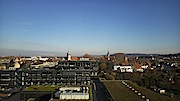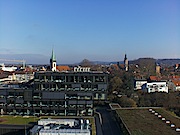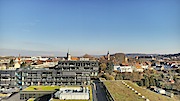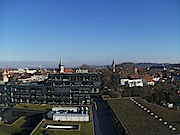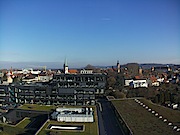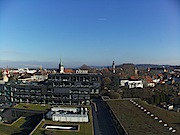Raspi Camera Module v3 vs HQ Camera
After the positive initial impressions on the Raspi Camera Module 3 the question now is how it stacks up against alternative camera modules. Obviously it will be better than the old camera modules 1 and 2 but what about the HQ Camera module that also got a slight feature bump at the same time as the camera module 3 was released?
Camera Module and Lens Specifications
The Camera Module 3 has a fixed autofocus lens. The HQ Camera Module comes with a C/CS lens mount but no lens. For this comparison we have the 6mm CCTV lens and the Pentax Cosmicar 8.5mm CCTV lens. The MSRP of the Camera Module 3 is $25 and for the HQ Camera Module it’s $50. Prices on the HQ Camera Lenses will vary and we have two cheaper variants for this test.
Unfortunately there are no equal focal lengths for the two sensors. The 28mm equivalent of the Camera Module 3 is common on smartphones while the 33mm equivalent of the 6mm lens the HQ Camera Module is a moderate wide angle and the 47mm equivalent of the Pentax 8.5mm a standard lens.
| Camera Module 3 | HQ Cam & CCTV | HQ Cam & Pentax | |
|---|---|---|---|
| Resolution | 11.9 MPix | 12.3 MPix | 12.3 MPix |
| Pixel Size | 1.4 µm x 1.4 µm | 1.55 µm x 1.55 µm | 1.55 µm x 1.55 µm |
| Sensor | Sony IMX708 | Sony IMX477 | Sony IMX477 |
| Stills Resolution | 4608 x 2592 pixels | 4056x3040 pixels | 4056x3040 pixels |
| Video Modes | 2304×1296p56, 2304×1296p30 HDR, 1536×864p120 |
2028×1080p50, 2028×1520p40 and 1332×990p120 |
2028×1080p50, 2028×1520p40 and 1332×990p120 |
| Sensor Size | 1/2.43” | 1/2.3” | 1/2.3” |
| Focus | Auto | Manual | Manual |
| Focal Length | 2.75mm | 6mm | 8.5mm |
| Focal Length (35mm equiv.) | 28mm | 33mm | 47mm |
| Max. Apterture | f/1.8 | f/1.2 | f/1.5 |
For the test setup we use libcamera-still with everything on auto for still images and libcamera-vid for videos, also everything on auto except the time to record, which is 10 sec.
Camera Module 3 vs HQ Camera Module
Looking at the Camera Module 3 and HQ Camera Module images sidy by side the first thing we notice is the different aspect ratio between the sensors. The Camera Module 3 has a 16:9 aspect ratio, while the HQ Camera Modules 4:3 aspect ratio is more commonly found in stills photography. Also, the focal lengths are quite different making us “zoom in” on the test frame while going through the pictures.
When it comes to image quality the Camera Module 3 not only seems to have the sharpest but also the most consistent lens in the field. The image is still sharp on the edges of the frame and there is no noticeable barrel distortion. Quite in contrast the 6mm lens. Despite beeing stopped down, the image is only sharp in the very center. Also a pronounced barrel distortion is noticeable. The Pentax 8.5mm is a little better in that regard but is also only really sharp in the center despite beeing stopped down to f/5.6.
The Camera Module 3 on auto takes a warmer approach to the overall colour of the image while the images from the HQ Camera Module have a cooler, bluer tone.
Camera Module 3 HDR Mode
The Camera Module 3 has an HDR mode. It drops the image resolution to 3MPix but gives you higher dynamic range. Here is an example with and without HDR:
HQ Camera Module with 6mm Wide Angle Lens
The 6mm wide angle lens was introduced with the HQ Camera Module in 2020 and has a variable aperture with 3 blades and manual focus. You can stop down the aperture manually but there are no markings as to what f-stop you selected. For our above test against the Camera Module 3 we use an image with the lens stopped down about a third. Here are two more images with the maximum aperture of f/1.2 and also one stopped down to about 2/3.
At maximum aperture the image is rather blurry. The image center gets better when stopped down just slightly but the edges are still very blurred. The sharpness at the edges improves when stopping down but the pronounced barrel distortion remains thoughout the aperture range.
HQ Camera Module with Pentax Cosmicar 8.5mm CCTV Lens
The Pentax Cosmicar just seems to be around on the internet, available from various sources but none of them has a full product sheet. Focus is manual. It has a clicky apterure ring with values on it though, so let’s go through the range:

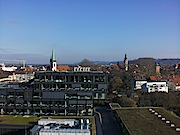
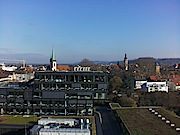
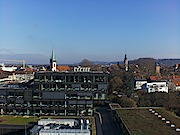
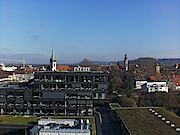
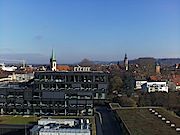

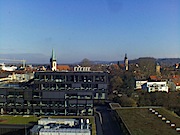
At f/1.5 not even the center is sharp and the edges are really bad. The center gets better at f/2 with the edges still lacking. The image clears up through the aperture range reaching its maximum at around f/5.6. After that diffraction kicks in and the image gets blurrier all over.
Camera Module 3 vs HQ Camera Module Video Comparison
Finally, the video test. Here all contenders deliver a 16:9 image. All settings are on auto. The 6mm lens is stopped down about a third and the Pentax is stopped down to f/4. The Camera Module 3 can output HDR video which in this case doesn’t even reduce the output resolution.
The Camera Module 3 puts out a video on the same level as the still images above. There is a little focus hunting but more annoyingly, the sensor seems to hunt for the right exposure making the image briefly darker and lighter quite often. This “exposure hunting” is even more pronounced in HDR mode:
The HQ Camera Module doesn’t suffer from the “exposure hunting” issue but from the low quality lenses:
Conclusion
The Camera Module 3 is a very compelling package for $25. It delivers smartphone like image quality even including an HDR video mode. We can only hope that a future software or firmware upgrade will fix the “exposure hunting” in video mode.
